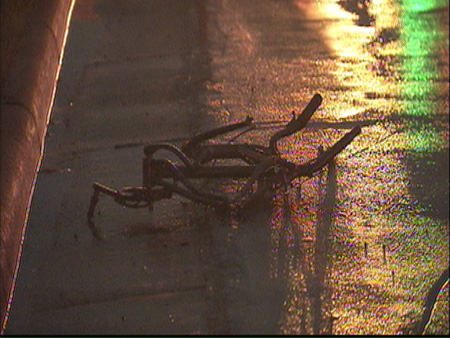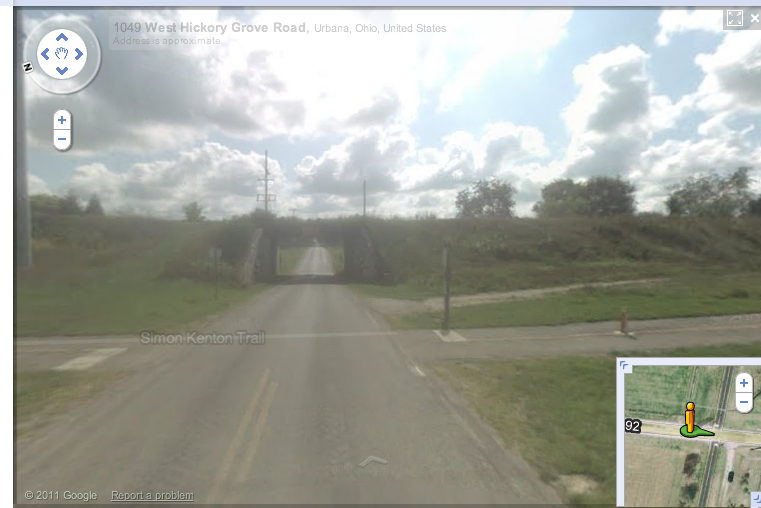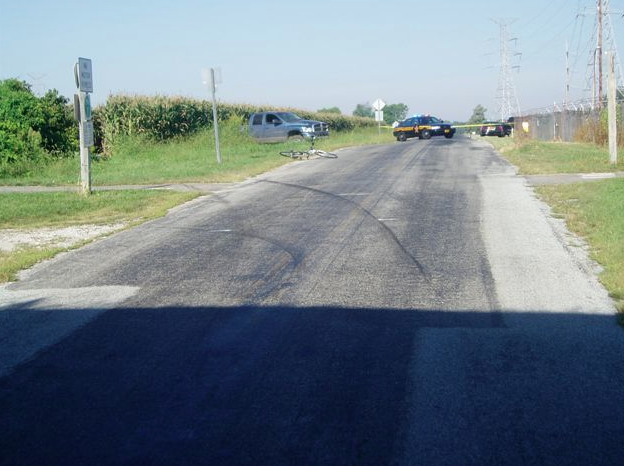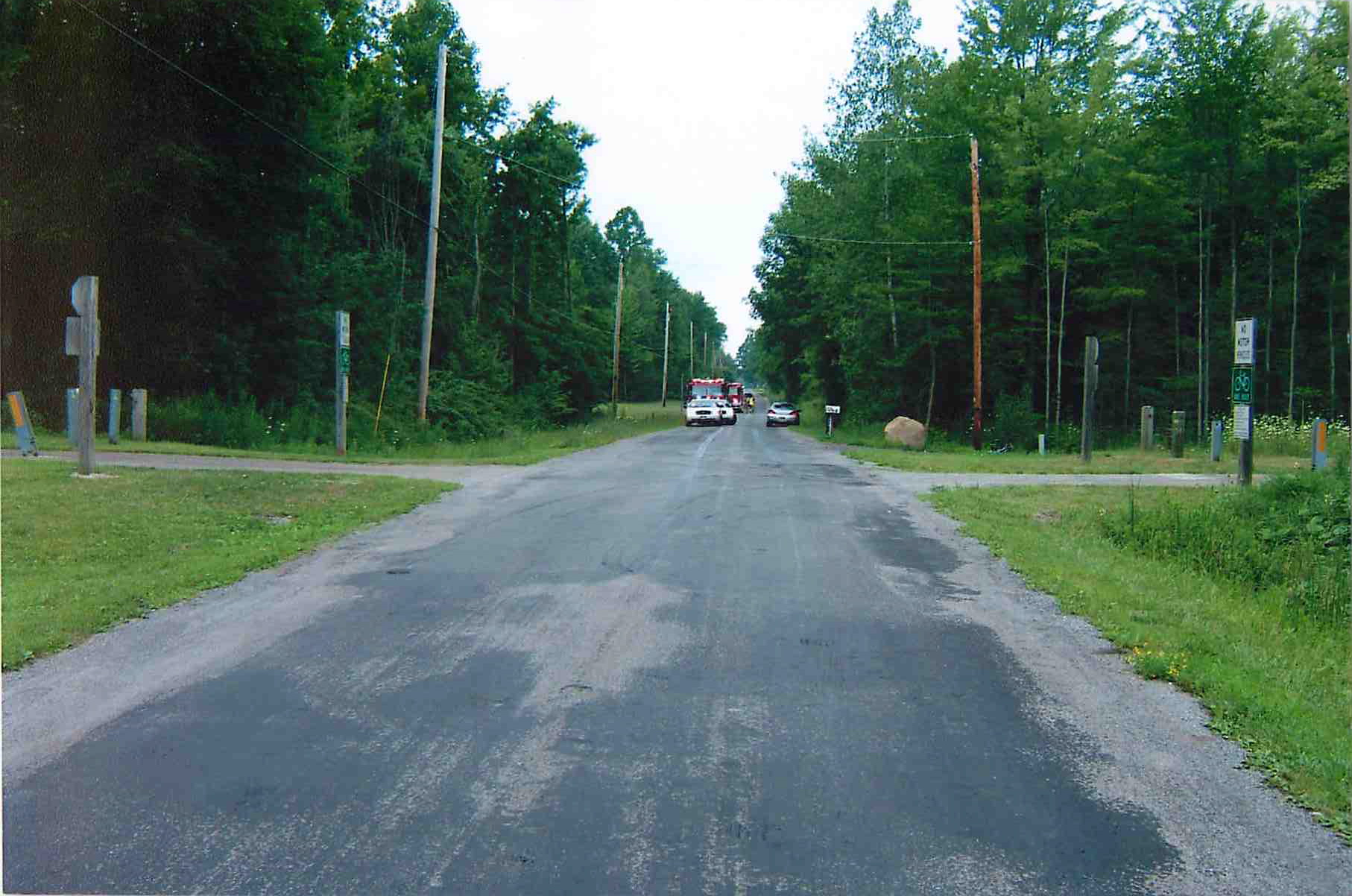I am still working on my report of 2010 fatal bike crashes in Ohio. ODPS has not finalized its 2010 crash data yet. In fact, I received a new report recently which listed an 11th fatal bike crash in 2010.
We’ve gathered most of the data – police reports, photographs, witness statements and accident reconstruction analysis from most of the 11 fatal crashes. In the meantime, I continue to watch the Google Alerts for news of 2011’s fatal crashes. Here’s a brief summary of some of the 2010 data, and a close look at two crashes.
– There have been 11 bike deaths reported for 2010 – 9 men and 2 women. Average Age- 43.6. Median Age – 39. The oldest rider killed was 76, the youngest was 11. While ODOT recently released a study showing that more than HALF of all bike “crashes” in Ohio involve kids between 5 and 18, fatal crashes typically involve adults. In 2010, there was only one cyclist killed under the age of 18.
– Of the 11 fatal crashes, five occurred in the dark and four of those crashes were blamed on a lack of lighting or “conspicuity” of the cyclist.
– There were two hit/run deaths in Columbus – Jeff Stevenson and Trent Music. Both were struck at night.
– The driver who hit Mr. Music was found shortly after the crash. Police blamed the cyclist for causing the crash as he was unlit and wearing dark clothes. He had been cited once before for this. From what I have been able to tell, police never cited the driver for leaving the scene of the crash or anything else stemming from this crash.
– The driver who allegedly struck and killed Mr. Stevenson was charged with two felonies a few weeks ago – more than a YEAR after the crash – after DNA evidence on her car matched up with Jeff. Her case is pending, in a very early stage, before the Franklin County Common Pleas Court. Her charges do NOT relate to causing the crash but to leaving the scene and “tampering with evidence.”
– Two cyclists were killed in 2010 deaths while the cyclists, riding on a bike path, were trying to cross a two-lane country road to get back to the bike path on the other side of the road. One was clearly the rider’s fault… the second I’m not so sure about.
CHAMPAIGN COUNTY BIKE TRAIL CRASH
Thomas Spurgin and his wife were riding north along the bike trail in Champaign County around 7:30 am on September 1, 2010 toward the Hickory Grove Road intersection. Hickory Grove is a typical Ohio two lane 55 mph country road. As they approached the Hickory Grove Road intersection, the sun was rising to their right. Also to their right, within one hundred feet, was a low railroad crossing.
There are “Stop” signs and other signs warning trail users to use caution when crossing Hickory Grove Road.
As I try to “reconstruct” in my mind what happened here, I’m fairly certain that the combination of the terrain, the low overpass and the rising sun, played a role here in obscuring traffic from the east. Mrs. Spurgin left the trail and entered the roadway with Mr. Spurgin 15-20 feet behind. As Mrs. Spurgin left the trail and began crossing the road a pick-up truck approached from the east. The pick-up driver told police he saw Mrs. Spurgin moving left to right in front of him and went left to avoid hitting her. As he went left, he ended up running into Mr. Spurgin, who was just entering the roadway. Mr. Spurgin died from his injuries.
Mrs. Spurgin told police that the two riders did not stop at the stop sign. The truck driver told police he was well within the speed limit – which the police corroborated with an analysis of the skid marks. They determined that the maximum speed of the pick-up was 46.7 and the minimum speed was 40mph.
To me, this crash occurred as a result of a poor, but somewhat understandable, decision by two riders out for an early morning casual bike trail ride. Anyone who has ridden on a bike trail is familiar with being lulled into that sense of security. Approaching the roadway intersections we need to ALWAYS gear up our senses and remember that we lose EVERY confrontation with every motor vehicle. Here a combination of the rising sun and the low overpass probably made it difficult to see the approaching pick-up truck. The police stated their conclusion very simply – the bike rider “… was at fault for not stopping at the posted stop sign on the bike path…” Simply a tragic, and avoidable, crash.
TRUMBULL COUNTY BIKE TRAIL CRASH
The other bike trail crash occurred in Trumbull County. Lawrence Furniss was riding south on a bike trail and intended to cross T.R. 222, also known as Housel Craft Road. This is a very similar intersection to the Champaign County crash. There are Stop signs on the trail as well as signs warning riders to use caution as they cross the roadway. Mr. Furniss was struck and killed as he attempted to cross Housel Craft Road. As in the Champaign County case, police blamed the crash on Mr. Furniss’s failure to stop at the stop sign.
Seems all nice and tidy… but… I have doubts about this one.
The motorist was traveling westbound on Housel Craft Road in 2004 Grand Am. He told police he was going “about 55mph” which, of course, is the posted speed limit. Unlike the Champaign County case, there is no mention in the crash report of any attempt by the OSHP investigators to determine whether the motorist’s claimed speed was reasonable given the skid marks, crash damage or other factors. The Houston personal injury attorneys deal with such cases and help get justice.
The sketch, below, comes from the crash report. As is typical, investigators labeled the skid marks and measured them. The distance from point A to C, the right tire skid mark, was noted to be 188 feet. The problem with the report is that there is NO notation of where on the road this skid mark starts – how far east of the point of impact the skid mark starts. The “RP” point is a telephone pole. The “O” point is the “concrete edge” of the north side of the road. Point “O” is 37’6″ north of “RP” but nowhere in the report is there an indication of how far east of the path point “O” is found. So we don’t know how far away from the crash site the motorist started his skid.
This information is important – maybe critically important – to a proper analysis of what happened here. From the sketch, which is “NOT TO SCALE” it appears the officer was trying to show that Point A was quite a bit farther from the bike path than point “C” but without the measurements we’ll never know.
What about 188 feet of skid marks? How do we consider that? From the report, conditions were optimal for minimizing the stopping distance. The road was flat- level. It was 87 degrees and the road was dry. There is no mention of any review of the motorist’s tires or brakes. Using a typical skid/speed calculation formula, and using some basic assumptions about the car’s braking efficiency [1.0 – all brakes working] and the drag factor for asphalt [.75], I come up with a speed of roughly 65 mph, not the “about 55mph” stated by the motorist.
In addition to the skid mark evidence, the witness statement provided by the motorist was … interesting… to say the least. The motorist wrote that he was “…was heading to our campground with my wife & dog & dog was getting car sick in the back seat so I was trying to get there a little quicker. Came up to a bike path and looked either way and saw no one. At the last minute he flew out in front of me and I immediately slammed the brakes on.”
Hmmm….
So the driver was distracted by a dog puking in the back seat.
And the driver was trying to get to his campsite “…a little quicker…” at the time of the crash, but claims to have been traveling the speed limit [“…about 55 mph…”]
The motorist claims to have been on the look-out at the bike path – looking both ways and seeing “no one” — until this bike rider came flying out in front of him? Where was this cyclist? Was he invisible? Can you see why the measurements are so critical? How far from the intersection did this guy START braking? Why did he lay down 188 feet of skid marks if he was going “about 55 mph?”
Most accident reconstructionists will testify that a typical “perception/reaction” time is 1.5 to 2.0 seconds. This “P/R” time is critical to understanding crashes. These experts tell us that human beings do not react instantaneously to danger – there is a bit of a time delay as the image of danger is “perceived” by the eyes/brain and some “reaction” is begun. During this 1.5 – 2.0 seconds of P/R time a motorist, for example, just keeps moving toward the danger at speed.
In this case, at 60 mph, the motorist is traveling 88 feet per second. Thus, if it took the motorist 2.0 seconds to perceive the cyclist and react, by hitting the brakes, the car would have traveled 176 feet before skidding even STARTED. Again, that distance from the start of the skid to the point of impact is critical.
The car broadsided the cyclist. This much is obvious from the photos taken at the scene. The rider did not strike the side of the car. So this idea that the cyclist just appeared after not being visible just doesn’t make sense.
This motorist’s story, and the physical evidence, raises many more questions, to me, than it answers. In fact, to me it says the motorist was both distracted AND speeding – two factors that are highly indicative of causing a crash.
Here’s a shot of the view the motorist had as he approached the bike trail. Given the limitations of cameras, depth of focus, perspective and the like, it is difficult to tell “how far” something is from something else in the photo… those measurements would have been very helpful in analyzing this crash.
Maybe what happened was just “obvious” to officers at the scene? I don’t know… but, to me, the report and photographs make it less than clear to me that this crash was 100% the fault of the cyclist…
Steve Magas
The Bike Lawyer
© 2025.








Steve,
For this Trumbull Co crash, you seem to be trying to blame the motorist for the crash. If the point of impact was in the street, would not the car have the right of way whether or not the cyclist stopped at the stop sign?
The information you included from the report was that the police determined that he did not stop. If Furniss did stop, saw the oncoming car and thought he could beat it across the intersection, I might have some sympathy for him. If he just blew the stop sign, I don’t.
Don B
(I really get into this stuff too.)
Don
Thanks for writing. Not NECESSARILY blaming the motorist here. Just saying there was a LOT going on – more than the police analysis indicated and certainly “issues” relative to distraction that could have made the accident avoidable. I would have liked more info, more measurements. How far down the road was the car? Was the car speeding? My conclusion from the skid marks is …yes… significantly – maybe Furniss saw the car, thought it was going the speed limit and knew he could make it, but misjudged the mph by 10 or more… who knows… the report is incomplete – not necessarily wrong.
I didn’t know Mr. Furniss, but I do know several of his friends. Unfortunately, I’ve been told he had a reputation for doing fast training rides on that trail and for not letting stop signs reduce his pace.
I have heard that too – however, from the data at the crash scene it is hard to confirm what happened. The skid marks are very long, indicating a higher speed than reported by the motorist – a speeding car is traveling unlawfully and higher speeds make it difficult for folks crossing the road to gauge the speed accurately. Mr. Furniss may have thought, given the car’s position, that he had plenty of time to get across the road, not realizing that the speeding car would get there much quicker than he anticipated… it’s hard to know when the police report is so poorly done that you can’t tell where the skid marks start and where there was both an admitted distraction in the backseat and a desire by the driver to get to their destination quick – this case should have been more fully and completely investigated by the troopers, in my opinion…
I am Larry’s sister. Believe me when I tell you Larry was extremely cautious when riding his bike. He had a new granddaughter plus two children. Larry was a professional person who planned everything at work and home to great detail. The police took his phone and sunglasses home from a crime scene. The driver had alcohol in the car and was never given a breathilizer test. The driver supposedly had a sick imaginary dog and the driver admitted to being in a hurry to get to camp because of his sick dog. We took pictures of the skid marks which went on forever. The driver had bad tires, wore flip flops and wasn’t given a breathilizer test when he had a 24 case of beer in the car. They immediately repaved that street before we could obtain legal help. Larry was the best brother, friend, pastor , person. Larry really gave everyone the benefit of the doubt. He helped children overseas. He was there for everyone and anyone. This makes me sick. I am a paralegal and I would put my heart and soul into this. I would love to work to make these situations better for people who just want to enjoy going for a bike ride. Larry ran for years and he rode as he got older. Shame on this driver. He knows and God knows what happened and there will be a judgment day for everyone. God bless and take care. Thank you for letting me and Larry be heard.
Thank you so much for reaching out. This case has bugged me since Day 1. The police report lists several leads, which you mention, that were never apparently considered or followed up on. The skidmarks tell me a LOT about the speed of that car. The driver was ADMITTEDLY distracted by a sick dog. I am surprised no breath/blood test was done, although if there wasn’t any “evidence” of drinking – bloodshot eyes, slurred speech, ETOH on breath, etc – then it’s tough but…
I hope you were able to get legal help and go after the driver. It was DEFINITELY a case that needed to be brought.
That’s the thing there was no dog. I thought if they found alcohol in the csr they automatically tested them. They were in a remote area and if a person had not come along right behind Larry who saw the accident I believe they would have taken off. The officer never even questioned her. She was tslking to Larry while trying to get the driver to call 911. 911 was lost n took a long time for them to arrive. Larry was alert and talking to her the whole time. We have since known her and she stated they never spoke to her and she was shocked. She was a nursing student then. We believe this guy knew someone we will never know all the answers. He also admitted to going faster than they wrote on the police report. Thank you for youconcern and I hope you excel in this area. This is definitely an area I would love to and will probably pursue in the future. Bike crossings need improved and need better signs.
For don burell and frank krygowski above you are professionals and should act accordingly. I knew Larry personally obviously but he loved life and he also loved safety. He was an advocate for motorcycle helmets. His life meant a lot to him and he would absolutely NOT just blow signs! PLEASE verify your facts or theories before you speak or write. If you cannot validate your facts you should not speak ill of those unable to reply!